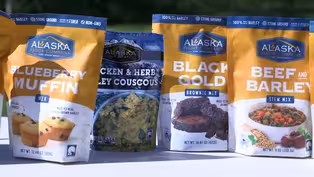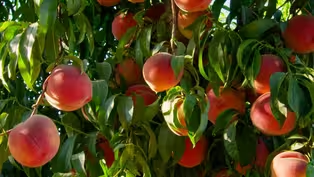
California Almonds
Clip: 6/30/2023 | 5m 15sVideo has Closed Captions
Meet an almond farmer whose parents immigrated from India.
Meet an almond farmer whose parents immigrated from India and settled in California’s fertile Central Valley. Thanks to its Mediterranean climate, nearly all the almonds Americas eat come from the Central Valley. California supplies close to 80 percent of the world's almonds.
Problems playing video? | Closed Captioning Feedback
Problems playing video? | Closed Captioning Feedback
America's Heartland is presented by your local public television station.
Funding for America’s Heartland is provided by US Soy, Sustainable Agriculture Research and Education, Rural Development Partners, and a Specialty Crop Grant from the California Department of Food and Agriculture.

California Almonds
Clip: 6/30/2023 | 5m 15sVideo has Closed Captions
Meet an almond farmer whose parents immigrated from India and settled in California’s fertile Central Valley. Thanks to its Mediterranean climate, nearly all the almonds Americas eat come from the Central Valley. California supplies close to 80 percent of the world's almonds.
Problems playing video? | Closed Captioning Feedback
How to Watch America's Heartland
America's Heartland is available to stream on pbs.org and the free PBS App, available on iPhone, Apple TV, Android TV, Android smartphones, Amazon Fire TV, Amazon Fire Tablet, Roku, Samsung Smart TV, and Vizio.
Providing Support for PBS.org
Learn Moreabout PBS online sponsorship♪♪ [Mallvinder Kahal] You're making a commodity that people are going to eat, that's going to sustain people.
You know?
It is busy.
It is hard to sometimes sit down, take a breath.
But when you do get those times, I think that's when you absolutely appreciate everything you have going on.
Mallvinder Kahal is a second generation almond farmer in California's Central Valley.
He and his brother run their family's growing and packing operation on nearly 2500 acres of land across Madera County, in the heart of the Golden State.
The family's farm roots stretch back many years and many miles.
[Mallvinder] So, about 40 years ago, my parents immigrated from India.
Historically, they came from an area that was all farming.
Their parents and their parents before them were doing farming in the Punjab region in India.
And so, when they came out here, they were looking for opportunity, and farming was something that naturally attracted them, you know?
It was already a part of their heritage.
And so, slowly but surely, they settled in the Central Valley, and they bought their first farm well over 30 years ago.
They dabbled in a little bit of everything that California was doing at the time.
They did wine grapes, apples, peaches, pistachios.
But ultimately, I think we just kind of found our home in almonds.
It's what made the most sense to us.
Thanks to its Mediterranean climate, nearly all of the almonds Americans enjoy come from the Central Valley, and California supplies close to 80% of the world's almonds.
[Mallvinder] There are countless almond varieties, and each one of them has a different purpose, a different market.
The variety of almonds Mallvinder is harvesting today are called Monterey.
[Mallvinder] Harvest typically spans from August to the end of October.
You know, it's very time sensitive because we want to make sure when we go in, the nuts come completely off the tree.
And that's where our shakers come in.
They're grabbing the tree at the perfect speed, you know, for four- three to four seconds of shaking all the nuts off the tree.
And then it moves on to the next tree, and the next tree, and so on and so forth.
From there, we're able to collect the almonds and they're picked up, dropped into a cart, and then the cart takes them to an elevator and that elevator dumps them into these, uh, hopper trailers that are pulled by semis.
The almonds are then sent to the processing facility where they are cleaned, graded and packed.
[Mallvinder] We are currently distributing almonds all across the globe.
Demand for almonds is as strong as ever.
Rick Kushman of the Almond Board of California says that's because of all of the new ways these nuts are being used.
[Rick] Among all the products on Earth that get introduced every year, almonds are right at the top, and there's been 12,000 new products introduced with almonds just last year.
And all of them involve health, and that's one of the things that's really driving it.
[Mallvinder] You know, in the last decade, we've seen a lot of great trends in terms of how almonds are used from almond milk to almond butter.
I think people are really valuing the nutritional density that almonds provide and how it can be great alternatives to other food sources.
And so, we've seen an explosion of creative uses of almonds.
♪♪ Being a farmer requires you to be, you know, essentially, a jack of all trades.
You can't rely outsourcing every single thing in your operation, but I think farmers are used to that.
What can be challenging, even more so, is learning to adapt.
The world is constantly changing.
California, changing more so than a lot of other places.
[Rick] California farmers all face the same challenge, which is climate change and drought.
Almond growers, uh, have been funding research back into the 1980s.
In fact, uh, in the- in recent decades, they've increased their water efficiency, in essence, reduced the amount of water to grow the same amount of almonds, by 33%.
And we have a goal in the industry of another 25% by 2025.
And by all measures, we're on... we're on target.
So, they understand that water efficiency is huge and they try to be as sustainable as possible in everything they do.
[Mallvinder] So, the industry is always finding ways to be innovative on not letting anything go to waste.
The consumer eats the kernel, but there's also the shell, there's the hull, even those are recycled for things such as cow feed, bedding, amongst other uses.
Even when we're done with the orchard, you know, and it's reached the end of its lifecycle, we even recycle the tree itself.
We'll chip those trees and reincorporate 'em into the soil to provide value for the next crop coming in.
We try not to let a single thing go to waste.
[Rick] I would love for people, when they pick up an almond, to see a face like Mallvinder's and to understand, you know, the love that goes into it and the care for the land and the trees and everything else that goes into that product.
[Mallvinder] I think the future of California almonds is bright.
The fact of the matter is we're evolving.
We don't stop evolving.
We're providing a great product, and I think it only gets better from here on out.
Video has Closed Captions
Clip: 6/30/2023 | 5m 24s | An Alaska family builds a flour factory right on their barley farm. (5m 24s)
Video has Closed Captions
Clip: 6/30/2023 | 6m 15s | Fresh, ripe summer peaches are the top crop at this Fresno farm. (6m 15s)
Panzanella Salad – Farm to Fork with Sharon Profis
Video has Closed Captions
Clip: 6/30/2023 | 5m 11s | Make a Peach and Tomato Panzanella Salad at peak season. (5m 11s)
Providing Support for PBS.org
Learn Moreabout PBS online sponsorshipSupport for PBS provided by:
America's Heartland is presented by your local public television station.
Funding for America’s Heartland is provided by US Soy, Sustainable Agriculture Research and Education, Rural Development Partners, and a Specialty Crop Grant from the California Department of Food and Agriculture.


















